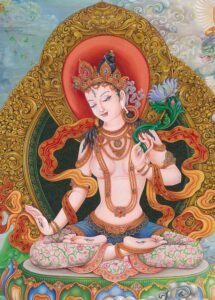
- Ujay Bajaracharya
- 2018
- Kathmandu,Nepal
- Painting
- Poster colour on canvas
- Nil
- 48.3x35.2 cm
- Museum of Nepali Art,Kathmandu,Nepal
Present painting of White Tara is a masterpiece of contemporary Paubha painting from Kathmandu, Nepal. She is represented by white in colour, a blue lotus and a third eye over on forehead which are prominent features of White Tara. The White Tara (Sanskrit: Sitatara; Tibetan: Sgrol-dkar) was incarnated as the Chinese princess. She symbolizes purity and is often represented standing at the right hand of her consort, Avalokiteshvara, or seated with legs crossed. Her inner virtue of loving compassion is magnified by the simplicity of her presentation. White Tara is an important Vajrayana Buddhist figure since she embodies the principle of loving-kindness, which is the central quality in the altruistic Bodhisattva presented through Mahayana Buddhism.
The White Tara mantra has a number of variations, but a common one in its Sanskrit form is:
OM TARE TUTTARE TURE MAMA AYUH PUNYA JNANA PUSTIME KURU SVAHA.
The Tibetan way to say the mantra is this:
OM TARE TUTTARE TURE MAMA AYUR PUNE GYANA PUNTIN KURU SOHA

